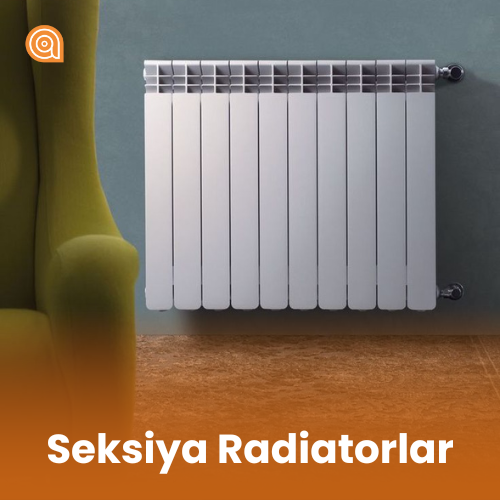Section Radiators | Effective Solution for Heating System

What Are Sectional Radiators?
Sectional radiators are heating systems composed of individual sections, with each section functioning as a separate heating element. The key feature of these radiators is their modularity, allowing sections to be added or removed to meet specific heating requirements.
Features of Sectional Radiators
- Adjustable Size: The heating power and capacity of the radiator can be modified by increasing or decreasing the number of sections.
- Material Types: Sectional radiators are typically made from aluminum, steel, or cast iron, each with its own advantages and disadvantages:
- Aluminum: Lightweight, quick to heat, and aesthetically pleasing.
- Steel: More durable and long-lasting.
- Cast Iron: Slower to heat but retains heat for a longer time.
- Efficient Heating: The design allows for even heat distribution through air and water circulation between sections.
- Easy Installation and Maintenance: Damaged or worn sections can be easily replaced.
Advantages of Sectional Radiators
- Economical and Practical: Customizable based on heating needs.
- Durable: High-quality materials ensure longevity.
- Aesthetic Design: Modern designs offer options that blend seamlessly with interiors.
Where Are They Used?
Sectional radiators are widely used in residential homes, offices, and industrial buildings. They are especially suitable for environments where flexible and efficient heating systems are required.
Types of Sectional Radiators by Material
Sectional radiators are categorized based on their manufacturing material, with each type offering unique benefits and characteristics:
-
Aluminum Sections
- Features:
- Lightweight and easy to install.
- Heats up quickly and distributes heat effectively.
- Available in modern designs and various colors.
- Advantages:
- Energy-efficient.
- Corrosion-resistant (especially painted models).
- Features:
-
Cast Iron Sections
- Features:
- Classic design, often used in traditional buildings.
- Slower heating but excellent heat retention.
- Advantages:
- Long-lasting (can be used for decades).
- High resistance to pressure and hard water.
- Features:
-
Steel Sections
- Features:
- Heats quickly and retains heat well.
- Modern and simple designs are ideal for interiors.
- Advantages:
- Suitable for long-term use.
- High heat transfer efficiency.
- Features:
-
Bimetal Sections
- Features:
- Made from a combination of aluminum and steel.
- Steel is used for internal parts, while aluminum forms the outer layer.
- Advantages:
- Resistant to high pressure and hard water.
- Combines aluminum’s lightweight and heat conductivity with steel’s durability.
- Features:
Maintenance and Cleaning of Sectional Radiators
To ensure sectional radiators operate efficiently and last longer, regular maintenance and cleaning are essential. Proper care also enhances energy efficiency and keeps the heating system in good condition.
-
Cleaning the Surface
- Dust and Dirt Removal: Dust on the surface can reduce heat output. Use a soft brush or a vacuum cleaner with a special attachment to clean it.
- Washing: Wipe the radiator’s surface with a damp cloth or microfiber. Avoid using harsh chemicals that may damage the paint.
-
Cleaning the Interior
- Removing Sediment and Rust: Over time, sediment (lime and rust) may accumulate inside the radiator, affecting water flow and heat transfer.
- Disconnect the radiator from the system and flush it with a special cleaning solution or warm water.
- If the buildup is extensive, seek professional help.
- Removing Sediment and Rust: Over time, sediment (lime and rust) may accumulate inside the radiator, affecting water flow and heat transfer.
-
Releasing Trapped Air
- When the heating system is running, some parts of the radiator may remain cold due to trapped air.
- Use the air release valve on the side of the radiator to let the air out. Once water starts flowing out, close the valve.
-
Corrosion Prevention
- Avoid Moist Environments: Moisture can cause rust. Ensure proper ventilation around the radiator.
- Protect the Paint: If the radiator’s paint gets damaged, repair it immediately with a special radiator paint.
-
Routine Maintenance
- Annual professional maintenance is recommended to check the radiator’s functionality and identify any issues in the system.
- Valves and Connections: Inspect connections and valves for leaks. Tighten or replace them if necessary.
-
Proper Usage
- Ensure Unobstructed Airflow: Avoid placing curtains, furniture, or other objects in front of the radiator, as this can hinder heat distribution.
- Prevent Overloading the System: Use the radiator within its recommended pressure and temperature limits.
Frequently Asked Questions About Sectional Radiators
-
What is a sectional radiator?
- A sectional radiator consists of multiple sections that work together as a heating device. Each section has a specific heating capacity, and the number of sections can be adjusted based on need.
-
What are the benefits of sectional radiators?
- Adjustable size and heating capacity.
- Lightweight and corrosion-resistant aluminum models.
- Expandable or reducible sections.
- Modern, aesthetic designs.
-
How to choose a sectional radiator?
- Determine the room size and heating requirements.
- Check the heating power of each section (measured in watts or kW).
- Ensure the radiator’s height and width fit the room dimensions.
- Consider the material (aluminum, cast iron, or steel).
-
How to maintain sectional radiators?
- Clean the interior annually.
- Wipe dust and dirt off the sections with a damp cloth.
- Regularly check for water leaks.
-
What causes water leakage in sectional radiators?
- Worn-out seals between sections.
- Improper installation.
- Damage from prolonged use.
